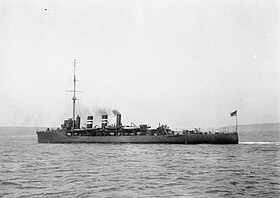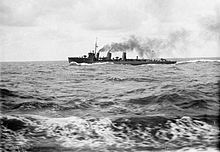HMS Amphion (1911)
|
|
|
|---|---|
| Active class | |
 HMS Amphion |
|
| Overview | |
| Type | Light cruiser |
| units | 3 |
| Shipyard | |
| Keel laying | March 15, 1911 |
| Launch | December 4, 1911 |
| delivery | March 1913 |
| period of service |
1913-1914 |
| Whereabouts | August 6, 1914 sunk after being hit by a mine |
| Technical specifications | |
| displacement | |
| length |
pp: 117.42 m (385 ft) |
| width |
12.66 m (41.5 ft) |
| Draft |
4.75 m (15 ft 7 in) |
| crew |
321-325 men |
| drive |
|
| speed |
25 kn |
| Armament |
|
| Fuel supply |
350 ts coal (max. 788 ts) |
| Armor | |
| Command tower |
102 mm (4 in) |
| deck |
25 mm (1 in) |
The HMS Amphion was a reconnaissance cruiser (" scout cruiser ") of the Active class of the Royal Navy . As a medium ship of the class, she was built with her two sister ships Active and Fearless at the state shipyard in Pembroke Dock .
The Amphion was the first Royal Navy ship to be lost
in World War I.
The Active class
The ships of the Active class were the last “scout cruisers” that the Royal Navy had built. Their role in supporting the fleet was increasingly taken over by the light cruisers, which came into service with the more than 5,000 ts displacement cruisers of the Town class parallel to the late "scout cruisers". The following eight ships of the Arethusa class of 3,500 ts attempted to combine the advantages of both types, which only succeeded in the C-class , which then displaced over 4,000 ts and of which 28 cruisers were built in seven subgroups.
The cruisers of the Active class were basically similar to the previous “scouts” of the Blonde class ; the noticeable external difference was the plow-like bow shape. Like the previous reconnaissance cruisers, the ships of the Active class had only a small amount of armor around the engine rooms. The ships were ordered from funds from the naval budget in 1911 and built in 1910 and 1911 in Pembroke , where the four turbine-powered “scouts” of the Blonde and Boadicea classes had previously been built. The Amphion and her sisters entered service with the Navy between December 1911 and October 1913. The Fearless , which was the last ship to be completed , was modified somewhat before delivery by reducing the main armament by two 102-mm guns and installing a 76-mm anti-aircraft gun and searchlights.
At the end of the war, the ships of this type were considered obsolete and the two remaining ships were sold for demolition in the early 1920s.
Mission history
The Amphion , launched on December 4, 1911, was when commissioned the flotilla commander of the 3rd Destroyer Flotilla with the Harwich Force , which was supposed to defend the eastern entrance of the English Channel . The first in command was the future Admiral Frederic Charles Dreyer (1878-1956), previously Chief of Staff of Vice Admiral Jellicoe , who developed the Navy's shooting procedures significantly and also won the fleet's shooting competition with the Amphion .
Fall of the Amphion
On the afternoon of August 5, 1914, the Amphion ran under Captain Cecil H. Fox with the 3rd Destroyer Flotilla after a fish steamer had sighted a suspicious ship that was "throwing things overboard". The Amphion led the flotilla to the position reported by the fish steamer according to a previously practiced search plan.
The auxiliary miner Queen Luise , running eastward, was soon discovered. The Seebäderschiff Queen Luise , which had been converted into a mine-layer , had left Emden on the night of August 4th to lay mines in the Thames estuary. For camouflage, it had been given the paint of the steamers of the Great Eastern Railway , which provided the ferry service between Harwich and Hoek van Holland . The Queen Louise tried to run away from the flotilla, which hardened the suspicion so that four destroyers, including Lance and Country Rail , began their pursuit. The first shots of the Royal Navy at sea against an enemy ship were fired by the Lance at about 10:30 a.m. at Queen Luise . After other destroyers and the Amphion had scored numerous hits and had no chance of escaping into neutral waters or defending themselves with the two existing revolver cannons, the German commander sank his ship by opening the sea valves and ordered the survivors to be bombarded into the lifeboats the Queen Louise at 12:22 PM burning at 51 ° 52 ' N , 2 ° 30' O sank first German warship the first world war. 46 men were rescued from the British ships, the number of dead varies between 54 and over 100.
The Amphion took over 38 of the survivors and continued the planned search voyage with the flotilla. After a short time, another ship was sighted that looked similar to Queen Luise and was flying a large German flag. The destroyers immediately attacked this ship while the Amphion identified her as the St. Petersburg of the Great Eastern Railway Company, which was bringing the German ambassador back to Germany from Great Britain. Amphion signaled this to the destroyers and ran between them and the St. Petersburg , as the fire was not stopped immediately. The St. Petersburg could then continue to run undisturbed.
On August 6, the Amphion broke off the search run at around 3:30 a.m. and ran back to Harwich with the destroyers. At 6:30 a.m. the Amphion ran at 20 knots on one of the mines dropped by Queen Luise during the escape. Except for one man, the operator of the bow gun was killed and almost all of the bridge personnel suffered severe burns. Since breakfast was served in the front exhibition deck, many crew members also died there. The temporarily unconscious master succeeded in stopping the engine, but flooding the bow spaces to smother the fire proved to be no longer possible.
The accompanying destroyers came up and tried to take over the crew with boats. At 7:03 a.m., the Amphion hit a mine again and the magazine exploded. Bullets hit the Lark and killed three shipwrecked people from the Amphion , including one of the German prisoners. The Amphion sank within 15 minutes. About 150 British sailors and 18 of Queen Luise's survivors died in her sinking .
The sinking place of the Amphion at 52 ° 11 ′ N , 2 ° 36 ′ E is protected by the Protection of Military Remains Act 1986 .
The sister ships
The two sister ships also began their war effort with the Harwich Force .
- Active : Launched on March 14, 1911, in service since December 1911 as a flotilla leader of the 2nd Destroyer Flotilla in Harwich, assigned to the Grand Fleet in 1915 and participant in the Skagerrak Battle , at the end of 1916 flotilla leader of the 4th Destroyer Flotilla in Portsmouth , in 1917 in Queenstown and then in the Mediterranean relocated; sold for demolition on May 21, 1920.
- Fearless : launched June 12, 1912; in service since October 1913 as flotilla leader of the 1st Destroyer Flotilla in Harwich, participant in the naval battle near Helgoland in August 1914 and the sea battle on the Skagerrak, at the end of 1916 flotilla leader of the 12th submarine flotilla of the Grand Fleet with the steam-powered submarines of the K -Class , involved in the series of accidents ironically called “ Battle of May Island ” on January 31, 1918 (in which the Fearless rammed and sank the submarine K17 ; a total of two submarines sunk, four and the Fearless considerably damaged, over 100 dead ); Fearless was still being repaired and sold on November 8, 1921 for demolition, which took place in Germany.
literature
- Randal Gray (Ed.): Conway's All The Worlds Fighting Ships 1906-1921. Conway Maritime Press, London 1985, ISBN 0-85177-245-5
- Carl Herbert: War voyages of German merchant ships. Broschek & Co, Hamburg 1934.
- Herbert Kuke: Helgoland course. Verlag Gerhard Stalling, Oldenburg 1974, ISBN 3-7979-1839-9
Web links
Footnotes
- ↑ Wartime Memories of HMS Amphion ( Memento of the original from April 15, 2009 in the Internet Archive ) Info: The archive link was automatically inserted and not yet checked. Please check the original and archive link according to the instructions and then remove this notice. (English, accessed March 1, 2011)
- ^ The First and Last Commonwealth Casualties (accessed March 1, 2011)
- ↑ German-navy.de: Queen Louise (auxiliary minelayer)
- ↑ The sinking of HMS Amphion ( Memento of the original from April 12, 2013 in the Internet Archive ) Info: The archive link was inserted automatically and has not yet been checked. Please check the original and archive link according to the instructions and then remove this notice.
- ↑ SI2008 / 950 designation under the Protection of Military Remains Act 1986

